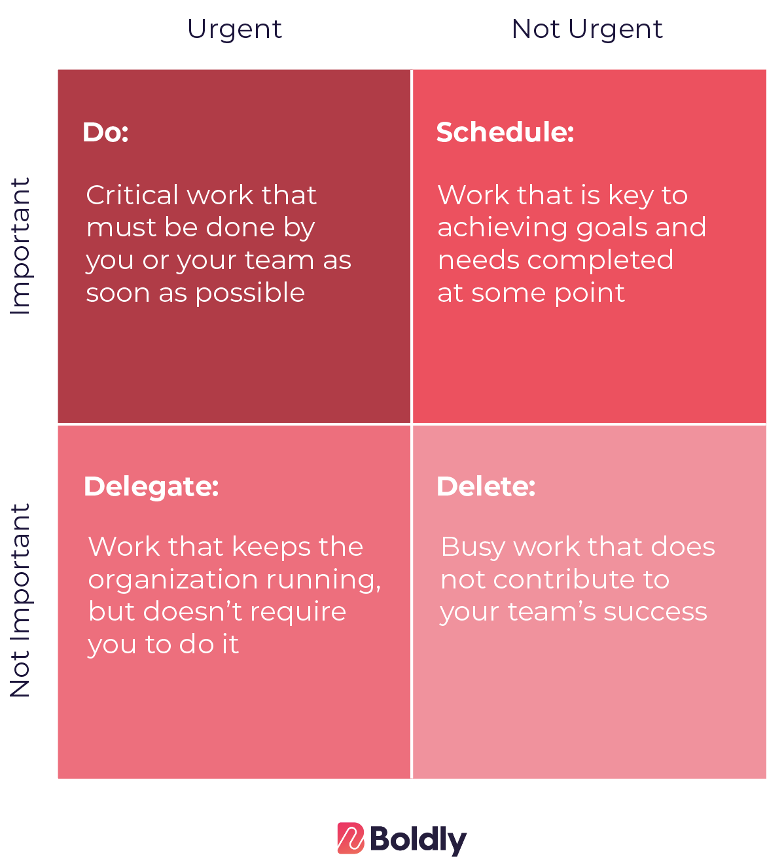Imagine getting the news that your team spent 62 percent of its time on administrative tasks.
As a senior executive, how would you handle that? Would you tolerate 38 percent productivity?
Probably not.
However, as it turns out, an Asana study of 10,264 employees found that’s what comprises the average manager’s day.
So let’s turn the lens from your team to your own working habits.
After helping thousands of senior executives increase their productivity, we have found the 3 keys the most effective leaders use to stop busy work so they can increase their productivity.
Here’s how senior executives can reduce busy work:
- Do the work that only you can do.
- Delegate out other key work.
- Delete work that doesn’t move the needle.
Best of all, you can put these strategies to work for you without adding more hours, effort, or energy to your work week.
What Does “Productivity” Mean For Executives?
Every great team needs talented individual contributors. However, a temptation for executives is to judge their own productivity by the same standards as a star performer.
Because an executive’s personal participation in any activity is a strategic allocation of a company’s resources, it’s key to define what it truly means for execs.
In High Output Management, Andy Grove explained that you measure a manager’s effectiveness by the output of their team and adjacent teams under their influence.
A leader’s productivity is not about personal efficiency, but how effectively their team achieves growth goals.
Increased productivity means getting better results in less time and with less effort.
Peter Drucker set the stakes for leaders well when he said:
“[Raising productivity] will ultimately determine the competitive performance of companies. Even more important, it will determine the very fabric of society and the quality of life in every industrialized nation.”
According to the legendary Drucker, the future of companies (and society itself) hangs on the true productivity of executives.
A Battle-Tested Productivity Matrix
Your time and attention are strategic deployments of your company’s resources.
First, leaders determine what gets measured, and therefore what gets done. Second, because your time and attention are billboards that signal what’s important.
Your first job is to personally get clear on the critical few projects and tasks that must be done to grow. Then, ditch the inessential many.
Unnecessary to-dos and cling-on projects are like weeds, they grow fast and steal resources from the plants that matter.
A familiar exercise to audit priorities is the Eisenhower Matrix.
President Eisenhower created these four simple boxes to help him navigate the unimaginable complexity of leadership on a global scale—where much more than corporate bottom lines were at stake.
The matrix has four quadrants, organized in two columns, labeled “urgent” and “not urgent,” and two rows, labeled “important” and “not important.”
Here’s how to use each:
- Urgent + Important: Critical work that must be done by you or your team as soon as possible.
- Not Urgent + Important: Work that is key to achieving your team’s goals and needs completed at some point in the future.
- Not Important + Urgent: Work that needs to be completed to keep the organization running but can be delegated to your team.
- Not Important + Not Urgent: Busy work that doesn’t contribute to your success and wastes company resources.


Do The Work Only You Can Do
As a leader, there are simply some things only you can do. These are the work of leadership and comprise your most important work, represented in the top row of the matrix.
These are things like:
- Business or group strategy
- Creating new products or services
- Key decision making
- Price or offer structuring
- Hiring and firing key team members
- Working with the CEO, board, or peer leaders
- Building relationships and developing positive company culture
However, to do what only you can do will mean mastering the science of delegation.
Delegate Key Work Using The “5Cs Of Delegation”
A 2015 Gallup study of 143 Inc. 500 CEOs found that companies run by senior executives who delegate well posted an average 3-year growth rate of 1,751% — 112 percentage points greater than those with limited delegation skills.
Delegation is a superpower. And no matter how experienced or talented, no leader can do it all.
Great leaders understand their role is to ensure their team has everything they need to do the work that yields results.
In simple terms, delegation can be broken into five component parts:
- Clarity: Define clear outcomes for your team’s efforts
- Creativity: Encourage autonomy in processes and working styles
- Culture: Build a healthy, productive, positive work environment
- Communication: Establish feedback loops and regular checkpoints
- Consideration: Give your team the resources to do the job right
An easy way to start delegating is by taking a task and assigning it in this template: {Who} will do {what} by {when}.
Things get done when everyone knows who owns an action, what success looks like, and has a deadline. This method works for everything from large-scale projects to regular daily, weekly, or monthly tasks.
What If There Is No One to Delegate To?
Delegating is critical to moving tasks, but what do you do if your team is at capacity or you don’t have anyone to delegate to?
- Consider adding fractional staff, such as a remote EA
- Leverage automation tools to alleviate routine tasks
One of the greatest productivity hacks for senior executives is hiring a fractional, remote executive assistant. Take email, for example. A fractional EA can easily filter, distill, and even answer most communications like these for a few hours each week.
Instead of constantly checking your inbox, getting pulled into weeds you don’t belong in, and feeling pressure to respond… you can simply address the strategic communications that actually require your time and attention.
This is ROI at its finest and where we’ve seen Boldly EAs shine brightest.
Delegation also has a close cousin named automation. There are tasks that tech can handle for you or your team.
Platforms like Zapier connect hundreds of apps and automate thousands of processes, like creating tasks from Slack messages or moving sales data from spreadsheets to dashboards. Otter.ai integrates with Zoom meetings and uses AI to transcribe meeting notes for free. Calendly can reduce the back-and-forth of scheduling meetings and remind you of important follow-ups and action items.
Magic happens at the intersection of people (delegation) and tech (automation).
Delete Work That Doesn’t Move The Needle
Finally, after focusing on your high-leverage activities and delegating work that needs to be done, but not by you, it’s time to delete what’s left.
The easy button here is answering this question: does this task meaningfully contribute to our goals?
Meaningful contribution simply means a project or task helps you either:
- Achieve your goals sooner, or
- Significantly increase margin through cost-cutting or profit increase.
If it doesn’t do one of those two things, it can be happily offered up on the chopping block. You may find culprits like:
- non-essential meetings or meetings that get off-track,
- overly fancy presentations and slide decks,
- useless reports or briefs that don’t expedite decisions,
- answering questions team members can find answers to,
- and plenty more!
When unsure whether or not to delete a given task, simply pause it for a week, and then measure if it was missed. If it went unmissed, you can delete it for good.
Unleash Your Productivity And Eliminate Busy Work For Good
The three keys of do, delegate, and delete can change the way you work—and the results you produce—for good.
We specialize in productivity because we believe great leaders with amazing teams can change business for the better. This framework will increase your leadership results and real productivity. However, if you lack key support staff like an executive assistant, project managers, or marketers, you will only get so far.
If this is you, delete the hiring headache and explore how quickly subscription staffing could change your life, company, and career.
Learn more about our rockstar remote staff and how you can get more done in less time.





